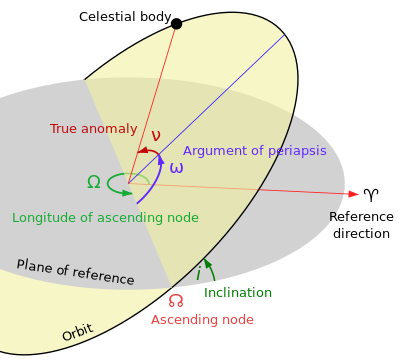Longitude of the ascending node

Thelongitude of the ascending node,also known as theright ascension of the ascending node,is one of theorbital elementsused to specify theorbitof an object in space. Denoted with the symbolΩ,it is the angle from a specified reference direction, called theorigin of longitude,to the direction of theascending node(☊), as measured in a specifiedreference plane.[1]The ascending node is the point where the orbit of the object passes through the plane of reference, as seen in the adjacent image.
Types
[edit]Commonly used reference planes and origins of longitude include:
- Forgeocentric orbits,Earth'sequatorialplane as the reference plane, and theFirst Point of Aries(FPA) as the origin of longitude. In this case, the longitude is also called theright ascensionof the ascending node(RAAN). The angle is measured eastwards (or, as seen from thenorth,counterclockwise) from the FPA to the node.[2][3]An alternative is thelocal time of the ascending node(LTAN), based on thelocal mean timeat which the spacecraft crosses the equator. Similar definitions exist for satellites around other planets (seeplanetary coordinate systems).
- Forheliocentric orbits,theeclipticas the reference plane, and the FPA as the origin of longitude. The angle is measured counterclockwise (as seen from north of the ecliptic) from theFirst Point of Ariesto the node.[2]
- For orbits outside theSolar System,the plane tangent to thecelestial sphereat the point of interest (called theplane of the sky) as the reference plane, and north (i.e. theperpendicular projectionof the direction from the observer to thenorth celestial poleonto the plane of the sky) as the origin of longitude. The angle is measured eastwards (or, as seen by the observer, counterclockwise) from north to the node.[4],pp. 40, 72, 137;[5],chap. 17.
In the case of abinary starknown only from visual observations, it is not possible to tell which node is ascending and which is descending. In this case the orbital parameter which is recorded is simply labeledlongitude of the node,☊, and represents the longitude of whichever node has a longitude between 0 and 180 degrees.[5],chap. 17;[4],p. 72.
Calculation from state vectors
[edit]Inastrodynamics,the longitude of the ascending node can be calculated from thespecific relative angular momentumvectorhas follows:
Here,n= ⟨nx,ny,nz⟩ is a vector pointing towards theascending node.The reference plane is assumed to be thexy-plane, and the origin of longitude is taken to be the positivex-axis.kis the unit vector (0, 0, 1), which is the normal vector to thexyreference plane.
Fornon-inclined orbits(withinclinationequal to zero), ☊ is undefined. For computation it is then, by convention, set equal to zero; that is, the ascending node is placed in the reference direction, which is equivalent to lettingnpoint towards the positivex-axis.
See also
[edit]- Equinox
- Kepler orbits
- List of orbits
- Orbital node
- Perturbation of the orbital planecan causeprecessionof the ascending node.
References
[edit]- ^Parameters Describing Elliptical Orbits,web page, accessed May 17, 2007.
- ^abOrbital Elements and Astronomical TermsArchived2007-04-03 at theWayback Machine,Robert A. Egler, Dept. of Physics,North Carolina State University.Web page, accessed May 17, 2007.
- ^Keplerian Elements TutorialArchived2002-10-14 at theWayback Machine,amsat.org, accessed May 17, 2007.
- ^abThe Binary Stars,R. G. Aitken, New York: Semi-Centennial Publications of the University of California, 1918.
- ^abCelestial Mechanics,Jeremy B. Tatum,on line, accessed May 17, 2007.

